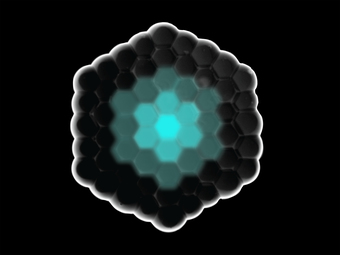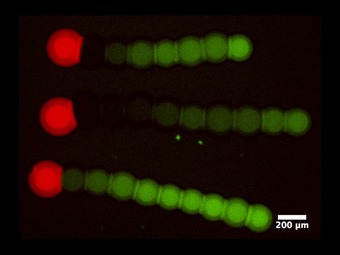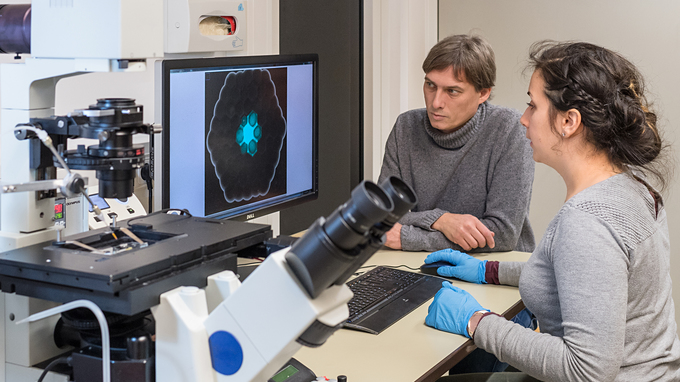Modelle des Lebens
Auch künstlich erzeugte Zellen können miteinander kommunizieren
2019-01-17 – Nachrichten aus dem Physik-Department
Weltweit arbeiten Wissenschaftlerinnen und Wissenschaftler derzeit daran, künstliche, zellartige Systeme herzustellen, die in der Lage sind, das Verhalten lebender Organismen nachzubilden. Friedrich Simmel und Aurore Dupin ist es nun erstmals gelungen, solche künstlichen Zellverbände in einer festen räumlichen Anordnung zu erzeugen. Der Clou an der Sache: Die Zellen können sogar miteinander kommunizieren.
„Unser System ist ein erster Schritt hin zu gewebeähnlichen, synthetischen biologischen Materialien, die komplexes raumzeitliches Verhalten zeigen und in denen sich einzelne Zellen ähnlich wie biologischen Organismen spezialisieren oder ausdifferenzieren könnten“, erklärt Friedrich Simmel, Professor für die Physik Synthetischer Biosysteme an der TU München.
Genexpression in einer festen Struktur

Als Grundbausteine für die künstlichen Zellen eignen sich Gele oder Emulsionströpfchen, umgeben von dünnen Fett- oder Polymermembranen. In den 10 bis 100 Mikrometer kleinen Einheiten können chemische oder biochemische Reaktionen ungestört ablaufen.
Das Forschungsteam nutzte von einer Lipidmembran umschlossene Tröpfchen und bauten diese zunächst zu künstlichen mehrzelligen Strukturen zusammen, sogenannten „Mikro-Geweben“. Die verwendeten biochemischen Reaktionslösungen in den Tröpfchen waren in der Lage, RNA oder Proteine herzustellen, die Zellen haben also eine Art Genexpression.
Signalaustausch und räumliche Differenzierung der Zellen
Doch damit nicht genug: Kleine „Signalmoleküle“ konnten über die Membranen oder über in die Membranen eingebaute Proteinkanäle zwischen den Zellen ausgetauscht werden. Damit ließen diese sich zeitlich und räumlich miteinander koppeln. Die Systeme wurden so dynamisch – wie im realen Leben.
Chemische Pulse liefen so durch den Zellverband und trugen Informationen weiter. Die Signale ließen sich auch als Auslöser nutzen, so dass sich anfänglich identische Zellen unterschiedlich entwickelten. „Unser System ist das erste Beispiel eines multizellulären Systems, in dem künstliche Zellen mit Genexpression eine feste Anordnung haben und über chemische Signale miteinander gekoppelt sind. Auf diesem Wege erreichen wir damit eine Form der räumlichen Differenzierung“, sagt Simmel.
Modelle, Minifabriken und Mikrosensoren

Solche synthetischen Systeme zu entwickeln ist wichtig, weil sie ein Studium grundlegender Fragen nach dem Ursprung des Lebens im Modell erlauben. Komplexere Organismen waren erst möglich, als sich Zellen spezialisieren und die Arbeit zwischen kooperierenden Zellen aufteilen konnten. Wie dies passierte, ist eine der spannendsten Fragen in der Grundlagenforschung.
Mit einer Art Modulbaukasten maßgeschneiderter Zellsysteme wollen die Forschenden künftig verschiedene Eigenschaften biologischer Systeme nachbilden. Zellen sollen auf ihre Umgebung reagieren und eigenständig handeln lernen.
Auch erste Anwendungen scheinen möglich: Die künstlichen Zellverbände lassen sich langfristig als Minifabriken einsetzen, um gezielt Biomoleküle zu produzieren, oder als winzige Sensoren in der Mikrorobotik, die Informationen verarbeiten und sich an ihre Umgebung anpassen können.
Zellen aus dem 3-D-Drucker
Derzeit müssen Friedrich Simmel und Aurore Dupin ihre Zellsysteme noch mühsam von Hand mit Hilfe von Mikromanipulatoren zusammenbauen. Sie planen jedoch künftig Kooperationen etwa mit der Hochschule München, um die Systeme mit Hilfe von 3-D-Druck-Techniken gezielt größer und lebensnäher bauen zu können.
Veröffentlichung
Weitere Informationen
Gefördert wurde diese Arbeit durch das European Research Council und den DFG Exzellenzcluster Nanosystems Initiative Munich (NIM). Aurore Dupin wurde unterstützt von der DFG Research Training Group „Chemical Foundations of Synthetic Biology“.
Verwandte Meldungen
- Akkordarbeit am Nano-Fließband – 2018-01-19
- Friedrich Simmel und Franz Pfeiffer erhalten ERC-Grants – 2016-04-25
- Das Tausend-Tröpfchen-Experiment – 2014-02-24
